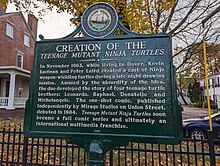Teenage Mutant Ninja Turtles, commonly abbreviated as TMNT, is a media franchise created by the comic book artists Kevin Eastman and Peter Laird. It follows Leonardo, Donatello, Raphael and Michelangelo, four anthropomorphic turtle brothers trained in ninjutsu who fight evil in New York City. Supporting characters include the turtles' sensei, a rat called Splinter, their human friends April O'Neil and Casey Jones, and enemies such as Baxter Stockman, Krang, and their archenemy, the Shredder.

Donatello, nicknamed Don or Donnie/Donny, is a superhero and one of the four main characters of the Teenage Mutant Ninja Turtles comics and all related media. He is the smartest and often gentlest of his brothers, wearing a purple mask over his eyes. He wields a bō staff, his primary signature weapon in all media.

Raphael, nicknamed Raph, is a superhero and one of the four main characters of the Teenage Mutant Ninja Turtles comics and all related media. In most iterations, he's depicted as the most aggressive of the turtle brothers, physically the strongest, and often at odds with his brother, Leonardo.

Michelangelo, nicknamed Mike or Mikey, is a superhero and one of the four main characters of the Teenage Mutant Ninja Turtles comics and all related media. Michelangelo is the most naturally gifted of the four brothers but prefers to have a good time rather than train. The most jocular and energetic of the team, he is shown to be rather immature; he is known for his wisecracks, quick-wit, optimism, and love of skateboarding and pizza. He is usually depicted wearing an orange eye mask. His signature weapons are a single or dual nunchaku, though he has also been portrayed using other weapons, such as a grappling hook, manriki-gusari, kusarigama, tonfa, and a three-section staff. He is commonly portrayed in media as speaking with a California accent.
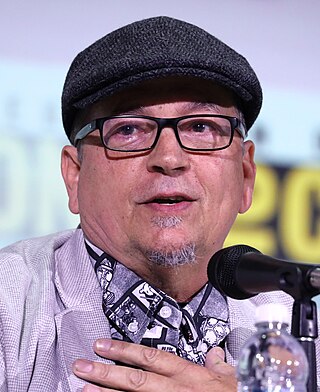
Kevin Brooks Eastman is an American comic book writer and artist best known for co-creating the Teenage Mutant Ninja Turtles with Peter Laird. Eastman was also formerly the editor and publisher of the magazine Heavy Metal.

Peter Alan Laird is an American comic book writer and artist best known for co-creating the Teenage Mutant Ninja Turtles with writer and artist Kevin Eastman.
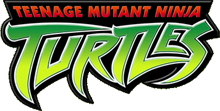
Teenage Mutant Ninja Turtles is an American animated television series developed by Lloyd Goldfine. It is the second animated series and third television series in the Teenage Mutant Ninja Turtles franchise. The series premiered on February 8, 2003, as part of Fox's FoxBox programming block and ended on February 28, 2009. A sequel film, Turtles Forever, serving as both the series finale of the series and a crossover with the 1987–1996 Teenage Mutant Ninja Turtles animated series, was released on November 21, 2009.
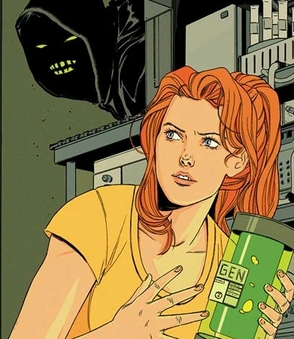
April O'Neil is a fictional character from the Teenage Mutant Ninja Turtles comics. She is the first human ally of the Ninja Turtles.
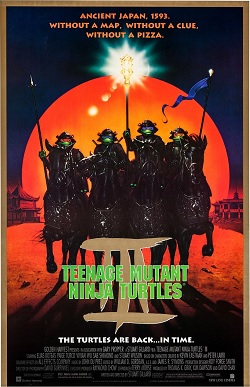
Teenage Mutant Ninja Turtles III is a 1993 American superhero action comedy film based on the Teenage Mutant Ninja Turtles characters created by Kevin Eastman and Peter Laird. Written and directed by Stuart Gillard, it is the sequel to Teenage Mutant Ninja Turtles (1990) and Teenage Mutant Ninja Turtles II: The Secret of the Ooze (1991), and the third and final installment in the original Turtles film trilogy. It stars Elias Koteas, Paige Turco, Vivian Wu, Sab Shimono, and Stuart Wilson with the voices of Brian Tochi, Robbie Rist, Corey Feldman, and Tim Kelleher. The plot revolves around the "Sacred Sands of Time", a mystical scepter which transports the Turtles and April back in time to feudal Japan, where they become embroiled in a conflict between a daimyō and a group of rebellious villagers.
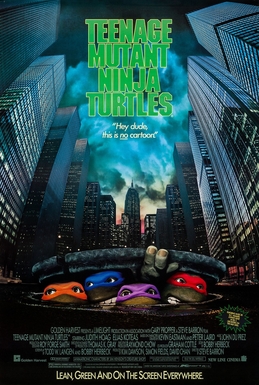
Teenage Mutant Ninja Turtles is a 1990 American superhero action comedy film based on the comic book characters created by Kevin Eastman and Peter Laird. It is the first film adaptation of the characters and was directed by Steve Barron and written by Todd W. Langen and Bobby Herbeck from a story by Herbeck. It stars Judith Hoag and Elias Koteas with the voices of Brian Tochi, Josh Pais, Corey Feldman, and Robbie Rist. Teenage Mutant Ninja Turtles follows the Turtles on a quest to save their master, Splinter, with their new allies, April O'Neil and Casey Jones, from the Shredder and his Foot Clan.

The Rat King is a fictional character in the Teenage Mutant Ninja Turtles multimedia franchise. The character was created by Jim Lawson and first appeared in the comic Tales of the Teenage Mutant Ninja Turtles #4 written by Jim Lawson and has made various appearances since, in the comic books and other media, such as animated series and video games.

Karai is a fictional supporting character appearing in Teenage Mutant Ninja Turtles comics and related media. She is usually a high-rank member of the Foot Clan outlaw ninja organization. She was originally introduced in Kevin Eastman and Peter Laird's comic book series Teenage Mutant Ninja Turtles in 1992. Since then, she has appeared in several different Teenage Mutant Ninja Turtles comics, television series, films, and video games. She is depicted as Shredder's second-in-command or adopted daughter in most versions and shares a rivalry with Leonardo and is at times considered his love interest. In one version of the comics, she is the granddaughter of the immortal Shredder, while in the 2012 series, she is Hamato Miwa, the only child of Hamato "Splinter" Yoshi and the late Tang Shen.

Venus de Milo is a fictional superheroine within the Teenage Mutant Ninja Turtles franchise. She first appeared in the television series, Ninja Turtles: The Next Mutation. There, she was portrayed by Nicole Parker and voiced by Lalainia Lindbjerg. She was the only female turtle prior to the introduction of Jennika in the IDW continuity in 2019, and Lita the following year. Venus is currently the only turtle named after a work of art, rather than an artist like the rest of the turtles.
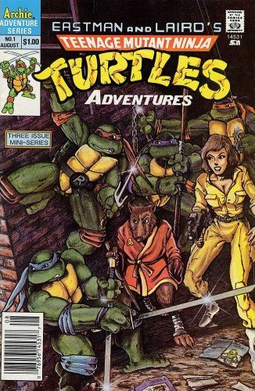
Teenage Mutant Ninja Turtles Adventures is an American comic book series that was published from August 1988 to October 1995 by Archie Comics. The series, which was aimed at a younger audience than other Teenage Mutant Ninja Turtles comics at the time, ran for 72 issues. In addition, there were numerous annuals, specials, and miniseries.

Action figures based on the Teenage Mutant Ninja Turtles franchise have been produced by Playmates Toys since 1988. Staff artists at the Northampton, Massachusetts based Mirage Studios have provided conceptual designs for many of the figures, vehicles, and playsets and are credited on the packaging of the products they created.

Tales of the Teenage Mutant Ninja Turtles, called Tales of the TMNT in its later Volume 2 incarnation, is an anthology comic book series published by Mirage Studios, starting in May 1987, presenting additional stories featuring the Teenage Mutant Ninja Turtles and their supporting cast as a companion book to the main Turtles comic series filling in the gaps of continuity in the TMNT universe. It was published in two distinct volumes.

Turtles Forever is a 2009 American animated superhero television film directed by Roy Burdine and Lloyd Goldfine and written by Goldfine, Rob David, and Matthew Drdek. A crossover film featuring two different incarnations of the Teenage Mutant Ninja Turtles fighting together, it was produced in celebration of the 25th anniversary of the characters and serves as the finale to the 2003 TV series. The film aired on The CW4Kids on November 21, 2009.
Mirage Studios was an American comic book company founded in 1983 by Kevin Eastman and Peter Laird in Dover, New Hampshire. The company was best known for the Teenage Mutant Ninja Turtles (TMNT) comic book series and the subsequent franchise it has spawned.
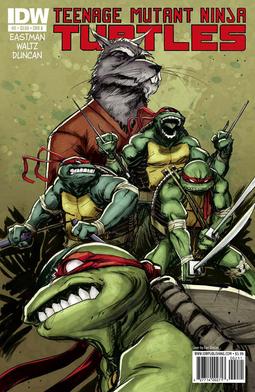
Teenage Mutant Ninja Turtles is an ongoing American comic book series published by IDW Publishing. Debuting in August 2011, the series is part of the Teenage Mutant Ninja Turtles media franchise created by Kevin Eastman and Peter Laird and was the first new comic incarnation of the Turtles to debut after the franchise's sale to Nickelodeon in October 2009. It is the fifth comic book series in the franchise's publication history and serves as a reboot of the franchise's story and characters.
Teenage Mutant Ninja Turtles, known as Tales of the Teenage Mutant Ninja Turtles for its 2017 fifth and final season, is an American animated television series developed by Ciro Nieli, Joshua Sternin, and Jennifer Ventimilia. It is the third animated series in the Teenage Mutant Ninja Turtles franchise. The series aired on Nickelodeon in the United States from September 28, 2012, to November 12, 2017. It was produced by Nickelodeon Animation Studio and LowBar Productions. Bardel Entertainment handled layout and CG animation services. The series begins with the Turtles emerging from their sewer home for the first time, using their ninjutsu training to fight enemies in present-day New York City.

